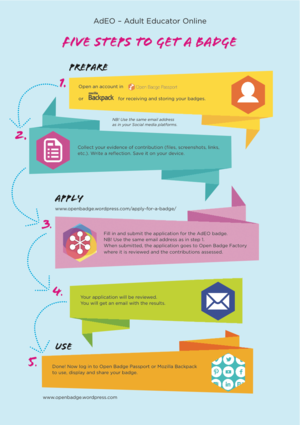This article is written like a personal reflection, personal essay, or argumentative essay that states a Wikipedia editor's personal feelings or presents an original argument about a topic. (October 2021) |

Gamification is the attempt to enhance systems, services, organizations, and activities by simulating experiences similar to those experienced when playing games in order to motivate and engage users.[1] This is generally accomplished through the application of game design elements and game principles (dynamics and mechanics) in non-game contexts.[2][3]
Gamification is part of persuasive system design, and it commonly employs game design elements[4][2][5][6][3] to improve user engagement,[7][8][9] organizational productivity,[10] flow,[11][12][13] learning,[14][15] crowdsourcing,[16] knowledge retention,[17] employee recruitment and evaluation, ease of use, usefulness of systems,[13][18][19] physical exercise,[20] traffic violations,[21] voter apathy,[22][23] public attitudes about alternative energy,[24] and more. A collection of research on gamification shows that a majority of studies on gamification find it has positive effects on individuals.[25][5] However, individual and contextual differences exist.[26]
Gamification can be achieved using different game mechanics and elements which can be linked to 8 core drives when using the Octalysis framework.[27]
- ^ Hamari, J. (2019). "Gamification". The Blackwell Encyclopedia of Sociology. Malden: Blackwell Pub. pp. 1–3. doi:10.1002/9781405165518.wbeos1321. ISBN 978-1-4051-2433-1. Archived from the original on 2022-02-26. Retrieved 2022-02-26.
{{cite book}}: CS1 maint: bot: original URL status unknown (link) - ^ a b Sebastian Deterding; Dan Dixon; Rilla Khaled; Lennart Nacke (2011). From game design elements to gamefulness: Defining 'gamification'. Proceedings of the 15th International Academic MindTrek Conference. pp. 9–15. doi:10.1145/2181037.2181040.
- ^ a b Robson, K.; Plangger, K.; Kietzmann, J.; McCarthy, I.; Pitt, L. (2015). "Is it all a game? Understanding the principles of gamification". Business Horizons. 58 (4): 411–420. doi:10.1016/j.bushor.2015.03.006. S2CID 19170739.
- ^ Huotari, K.; Hamari, J. (2012). "Defining Gamification – A Service Marketing Perspective". Proceedings of the 16th International Academic MindTrek Conference 2012, Tampere, Finland, October 3–5. Archived from the original on 2022-02-26. Retrieved 2019-03-14.
- ^ a b Hamari, Juho; Koivisto, Jonna; Sarsa, Harri (2014). "Does Gamification Work?—A Literature Review of Empirical Studies on Gamification". 2014 47th Hawaii International Conference on System Sciences. pp. 3025–3034. doi:10.1109/HICSS.2014.377. ISBN 978-1-4799-2504-9. S2CID 8115805. Archived from the original on 2022-02-26. Retrieved 2015-08-06.
- ^ "Gamification Design Elements". Enterprise-Gamification.com. Archived from the original on 2014-10-17. Retrieved 2014-10-07.
- ^ Hamari, Juho (2013). "Transforming Homo Economicus into Homo Ludens: A Field Experiment on Gamification in a Utilitarian Peer-To-Peer Trading Service". Electronic Commerce Research and Applications. 12 (4): 236–245. doi:10.1016/j.elerap.2013.01.004. S2CID 207558946. Archived from the original on 2014-04-06. Retrieved 2014-02-25.
- ^ Hamari, Juho (2015). "Do badges increase user activity? A field experiment on the effects of gamification". Computers in Human Behavior. 71: 469–478. doi:10.1016/j.chb.2015.03.036. S2CID 12168278. Archived from the original on 2022-02-26. Retrieved 2015-08-06.
- ^ Ruhi, Umar (2015-01-01). "Level Up Your Strategy: Towards a Descriptive Framework for Meaningful Enterprise Gamification". Technology Innovation Management Review. 5 (8): 5–16. arXiv:1605.09678. Bibcode:2016arXiv160509678R. doi:10.22215/timreview/918. ISSN 1927-0321. S2CID 4643782.
- ^ Zichermann, Gabe; Cunningham, Christopher (August 2011). "Introduction". Gamification by Design: Implementing Game Mechanics in Web and Mobile Apps (1st ed.). Sebastopol, California: O'Reilly Media. p. xiv. ISBN 978-1-4493-1539-9. Archived from the original on 2021-06-02. Retrieved 2012-12-10.
- ^ Hamari, J.; Koivisto, J. (2014). "Measuring Flow in Gamification: Dispositional Flow Scale-2". Computers in Human Behavior. 40: 133–134. doi:10.1016/j.chb.2014.07.048. S2CID 10930665. Archived from the original on 2014-10-18. Retrieved 2014-10-27.
- ^ Procci, K.; Singer, A. R.; Levy, K. R.; Bowers, C. (2012). "Measuring the flow experience of gamers: An evaluation of the DFS-2". Computers in Human Behavior. 28 (6): 2306–2312. doi:10.1016/j.chb.2012.06.039.
- ^ a b Philipp Herzig; Susanne Strahringer; Michael Ameling (2012). Gamification of ERP Systems-Exploring Gamification Effects on User Acceptance Constructs (PDF). Multikonferenz Wirtschaftsinformatik 2012 (MKWI'12). pp. 793–804. Archived from the original (PDF) on 2016-06-11. Retrieved 2014-08-02.
- ^ Hamari, J.; Shernoff, D. J.; Rowe, E.; Coller. B.; Asbell-Clarke, J.; Edwards, T. (2014). "Challenging games help students learn: An empirical study on engagement, flow and immersion in game-based learning". Computers in Human Behavior. 54: 133–134. doi:10.1016/j.chb.2015.07.045. S2CID 18525372. Archived from the original on 2016-09-19. Retrieved 2016-09-11.
- ^ Herger, Mario (July 17, 2014). "Gamification Facts & Figures". Enterprise-Gamification.com. Archived from the original on August 9, 2014. Retrieved July 27, 2014.
- ^ Morschheuser, Benedikt; Hamari, Juho; Koivisto, Jonna (2016). "Gamification in Crowdsourcing: A Review". 2016 49th Hawaii International Conference on System Sciences (HICSS). pp. 4375–4384. doi:10.1109/HICSS.2016.543. ISBN 978-0-7695-5670-3. S2CID 29654897. Archived from the original on 2016-09-19. Retrieved 2016-09-11.
- ^ Dincelli, Ersin; Chengalur-Smith, InduShobha (2020). "Choose your own training adventure: Designing a gamified SETA artefact for improving information security and privacy through interactive storytelling". European Journal of Information Systems. 29 (6): 669–687. doi:10.1080/0960085X.2020.1797546.
- ^ Hamari, Juho; Koivisto, Jonna (2015). "Why do people use gamification services?". International Journal of Information Management. 35 (4): 419–431. doi:10.1016/j.ijinfomgt.2015.04.006. S2CID 205281251. Archived from the original on 2022-02-26. Retrieved 2015-08-06.
- ^ Philipp Herzig (2014). Gamification as a Service (Ph.D.). Archived from the original on 2014-09-24. Retrieved 2014-08-02.
- ^ Hamari, Juho; Koivisto, Jonna (2015). ""Working out for likes": An empirical study on social influence in exercise gamification". Computers in Human Behavior. 50: 333–347. doi:10.1016/j.chb.2015.04.018. S2CID 16770937. Archived from the original on 2022-02-26. Retrieved 2015-08-06.
- ^ "The Speed Camera Lottery". TheFunTheory. Archived from the original on 2015-06-30. Retrieved 2015-07-07.
- ^ Furbert, Tinee (July 4, 2017). "Senator Furbert Educates Voters With Social App". BerNews Bermuda. Archived from the original on 15 August 2020. Retrieved 29 January 2021.
- ^ "Rethinking Elections With Gamification". HuffingtonPost. Archived from the original on 2015-09-15. Retrieved 2015-07-07.
- ^ Beck, Ariane; Rai, Varun (2016). "Serious Games in Breaking Informational Barriers in Solar Energy". SSRN 2816852.
- ^ Scorgie, D.; Feng, Z.; Paes, D.; Parisi, F.; Yiu, T.W.; Lovreglio, R. (March 2024). "Virtual reality for safety training: A systematic literature review and meta-analysis". Safety Science. 171: 106372. doi:10.1016/j.ssci.2023.106372. ISSN 0925-7535.
- ^ Koivisto, Jonna; Hamari, Juho (2015). "Demographic differences in perceived benefits from gamification". Computers in Human Behavior. 35: 179–188. doi:10.1016/j.chb.2014.03.007. S2CID 8408304. Archived from the original on 2022-02-26. Retrieved 2015-08-06.
- ^ "Framework". The Octalysis Group. 2023-09-15. Retrieved 2024-03-14.